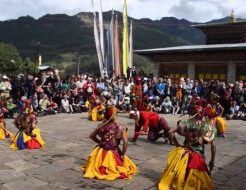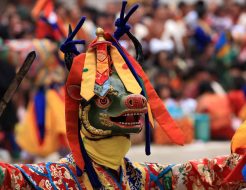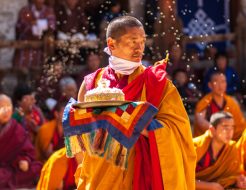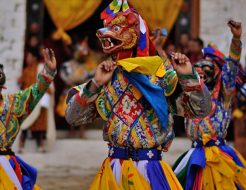- Airfare international & Domestic.
- Travel Insurance.
- Personal shopping.
- Alcohol.
- Laundry.
- Tips for Guide & Driver.
Jomolhari Trek is one of the most beautiful and popular high altitude treks in Bhutan, since you will have very good view of the mountains, scenery of alpine and camp at good campsites. You will also pass through several semi nomadic villages. This trek is also known as Snow Leopard or Soi Yaksa trek which is a week trek. Sometime if you are lucky you may spot Himalayan Snow Leopard during this week long trekking in Bhutan. Other Himalayan animals like Blue Sheep and Marmots can be seen quite often along the trek routes. The best time considered for this trek is in the spring and autumn months.
Bhutan visa cost USD: 40/.
Day 01: Arrive Paro (By Druk Air)
Day 02: Paro hike to Taksang Monastery (Tiger Nest)
Day 03: Drukgyel Dzong(Paro) – Shana (trek)
Day 04: Shana-Soi Thangthangka (trek)
Day 05: Soi-Thangthangka-Jangothang base camp (trek)
Day 06: Jangothang Halt (trek)
Day 07: Jangothang- Dhumzo Chhu or Chorapang (trek)
Day 08: Dhumzo Chhu – Thombu Shong (trek)
Day 09: Thombu Shong – Shana (trek) – Drive to Paro
Day 10: Paro – Thimphu (Sightseeing)
Day 11: Thimphu – Punakha (74 Km, 2 ½ hrs)
Day 12: Punakha – Paro sightseeing (115 Km, 3 ½ hrs)
Day 13: Departure from Paro international Airport
Day 01: Arrive Paro (By Druk Air)
The flight into Paro on our national carrier, Druk Air, is a befitting introduction to the spectacular beauty of our country. In clear weather, magnificent views of the world’s highest peaks, give way to the lush green Paro valley as you land. On arrival at Paro international airport, you will be received by our representative and will escort you to hotel. In the afternoon visit is Ta Dzong, an ancient watchtower, which now houses the National Museum. Below the museum is the Paro Rimpung Dzong, the centre of civil and religious authority in this valley. A short walk takes you to the base of the dzong and across a traditional cantilevered, covered bridge. A short distance further is one of the innumerable archery grounds. (Archery is the national sport of Bhutan). If we are lucky, we may catch a match in action.
Day 02: Paro hike to Taksang Monastery (Tiger Nest)
Right after the breakfast drive towards the road point to Taktshang. Taktshang Monastery, the most famous of Bhutan’s monasteries. Taktshang means “Tiger’s Nest,” so named because Guru Rimpoche reportedly flew to the site of the monastery on the back of a flying tiger in the late centuries of the first millennium. The monastery is perched on a cliff nearly 3,000 ft above the Paro valley floor. This day hike is not only historically and culturally interesting, but also incredibly scenic! It takes about two hours to reach the cafeteria, which gives a breathtaking view of the Tiger’s Nest. If you still feel like hiking then you can take another hour to reach the temple. Then return back to hotel and free evening.
Day 03: Drukgyel Dzong(Paro) – Shana (trek) Altitude: 2800m, Duration 5 hours, Distance 15 Km. Level of Difficulty: Easy
Starting form Drukgyel Dzong, the fortress that once guarded Paro Valley against Tibetan invaders, the first day is a pleasant walk following the left side of the Pachu River. The farm road serves as the trek route and passes through a number of very small villages with traditional houses, rice and vegetable fields to left and right of the trail.
After about an hour’s walk, the farm road ends at Mitsizamp. Crossing a bridge to the right side of the river, the trail climbs very gradually for another hour through the trees to Zakhapang (2,600m), where nice lunch break-spot in an open and clean space is found. After lunch the trek continues through blue pine forests, following the river closely. Gunyitsawa army outpost appears not long before the end of the first day’s trek. The campsite at Shana, just beyond, is situated at an altitude of 2,820m in a beautiful open space surrounded by blue pine forest. Two traditional houses on the other side of the wide, fast-flowing river make up Shana village.
Day 04: Shana-Soi Thangthangka (trek) Altitude: 3,750m, Duration 8 hours, Distance 20 Km. Level of Difficulty: Long but not difficult, Muddy and bumpy path some time
This is the longest trekking day, taking eight hours to reach the campsite. The trail continues to follow the river gradually ascending through a mixed forest of blue pine and oak and, later in the afternoon, tall rhododendron trees, birch, fir and maple. Though the trail is rocky and bumpy path, it is not strenuous but in rainy conditions it can be quite muddy. There are several simple wooden bridges to cross and sometimes the river reaches right up to the trail. The lunch break comes after about 4 hours of walking through an ever-narrowing valley: Shing Karap or Thombuzam are popular stopping places at around 3,305m.
Several trails lead in other directions, such as the trail to Tremo la, which was the old salt-trading route to Tibet. Not long before reaching the campsite the trail leads you up a ridge with a chorten. Beyond, in the distance, at the end of the valley the Jumolhari Mountain comes into view. Finally, after an 8 hours walk, you reach the campsite. The camp site is located in spacious clearing and directly faces Mount Jumolhari. The view of early morning sun striking the tip of Jumolhari is breathtaking. Mount Jumolhari, at 7326, is among the world’s highest mountains.
Day 05: Soi-Thangthangka-Jangothang base camp (trek) Altitude: 4050m, Duration 4 hours, Distance 12 Km. Level of Difficulty: Short and easy
The third day’s trek is a short one so it is possible to set off a little later and progress at a leisurely pace. When you reach the army outpost you are required to stop and register your entry permits issued by the army headquarters in Thimphu. This matter will be taken care of by your guide.
The Pachu River is again to the right and the trail passes through some very small villages. It will take less then four hours to reach Jangothang, Base Camp. The altitude at the base camp is 4,000m and is a beautiful place to spend the night. The imposing, rounded bulk of the Jumolhari Mountain fills the view to the Northeast and in the evening the profile of the ruined Jangothang Dzong, populated by huge ravens creates a mystical atmosphere. The area is rich in bird life. Birds sighted en route include the Fire-tailed Sunbird, Ibisbill, White throated Dipper, Yellow-billed Chough, Rosy Pipit, Snow Pigeon, Blue-fronted Redstart, Plumbeous Water Redstart, Blood Pheasant, Snow Partridge and many more.
Day 06: Jangothang Halt (trek)
Today is a day to rest and acclimatize to the altitude. The body also needs times to adjust to the falling temperatures, especially during the night. There is an opportunity to explore the valley and enjoy wonderful views of the mountains. A 2 hour’s leisurely hike will take you to the twin lakes of Tshophu. For those taking the Lingshi variation of the trek, this day trek hike is important. You can also enjoy the view of Cone-shape Jichu Drakey cannot fail to remind the clear blue sky. Jichu Drakey cannot fail to remind you of the Matterhorn from this perspective. It is a sight to hold! Many rank this as the most beautiful mountain in Bhutan.
Day 07: Jangothang- Dhumzo Chhu or Chorapang (trek) Altitude: 3800m, Duration 7 ½ hours, Distance 16 Km. Level of Difficulty: Strenuous
On the way you will see the view of Jhomolhari, Jitchu Drake and the valley to Jhomolhari camp site. Your will also come across the several yak harder’s tent, Tsho Phu lakes and normally see a flock of Himalayan blue Sheep high up on the rocky slopes. If you are lucky enough you may see the footprint of Snow Leopard at the Bonte La pass. Then the trail winds up till Bonte La (16,040 ft/4890m) and is also highest pass of this trek. Take a time to enjoy the scenery, have a snack or put up some prayer flags. From here you can see Basingthang Peaks(5500m), Chatarake(Djo Drake, Jo Darkey (5570m) and Kanchenjunga, the third highest mountain in the world. The trail drops through a steep, narrow gully with gravel and loose rocks till you reached Dhumzo. The Soi Yaksa Valley is a beautiful site with impressive rock cliffs, waterfalls, deep side valleys, and snow- covered peaks. Overnight at the camp.
Day 08: Dhumzo Chhu – Thombu Shong (trek) Altitude: 4150m, Duration 5 ½ hours, Distance 11 Km. Level of Difficulty: Moderate
You will have to climb from the camp through rhododendron, birch, oak forest draped in moss brings you to a meadow with huge Juniper tree and then lead s to Dhunge La (15,410ft/4700m) then to Tagulun La (14,880ft/4540m. You can also get a better view of Jhomolhari, Jitchu Drake and Teri Kang, and in the distance Kanchenjunga (28160ft/85840m) and even Makalu (27,760ft/8463m)blocking the view to Mount Everest. You can also see your tonight Thungbue camp. The Thangbue valley which has several stone huts-is busy in spring and autumn with number of families and hundreds of yaks, horses, dogs and goats. Thongbue camp is the second highest camp for the trek.
Day 09: Thombu Shong – Shana (trek) – Drive to Paro Altitude: 2800m, Duration 5 ½ hours, Distance 12 Km. Level of Difficulty: Moderate
Today you will cross the valley through a swampy area to a clear trail through rhododendron bushes climbing steeply to Thombu La (14,005ft/4270m). your can also see the several mountain peaks view from the pass. The ridge walk from the pass is one of the best parts of the trek: very high above the valleys on a good trail with a beautiful view. The trail descends steeply for 2 to 3 hours till you reach to the Shana where you will meet your car and driver. And drive for 45 minutes through the lovely valley, finishing your trek at Drugyel Dzong and then to your hotel in Paro for about another 30 minutes.
Day 10: Paro – Thimphu (Sightseeing)
Thimphu at an altitude of 3280 meters is the modern day capital of Bhutan. Sightseeing, visit the Memorial Chorten commissioned and built by the Queen Grand mother in memory of the late King. Visit the National Library, a treasure trove of priceless Buddhist manuscripts, visit the Traditional medicine centre where old healing arts such as acupuncture and herbal remedies are still practiced, the painting school, After 5 PM, visit Tashichho Dzong, “fortress of the glorious dharma” it is the center of government, religion, seat of the Kings Throne room and of the Je Khenpo or Chief abbot. It was rebuilt in the early 1960s after a fire destroyed most of the building. Overnight in Thimphu.
Day 11: Thimphu – Punakha (74 Km, 2 ½ hrs)
After breakfast, Drive to Punakha for 2 ½ hours with short stop at Dochula pass. If the weather is clear, you could have a superb view of the Bhutan’s Himalayas. Have lunch in Punakha town and visit beautiful Punakha Dzong built in 1637 by Shabdrung Ngawang Namgyal. Based on the prophecy of Guru Padmasambava the dzong is situated between two famous rivers, Pho Chu (Male River) and Mo Chu (Female River). Punakha was also the capital of Bhutan until 1955. Night halt in Punakha.
Day 12: Punakha – Paro sightseeing (115 Km, 3 ½ hrs)
Drive to Paro and check in at the hotel. Your lunch will be in Paro town. After lunch visit the Drugyel Dzong, or the fort of Drukpa victory which is almost 10 miles north from the town. From this fortress Bhutanese repelled several invasions by Tibetans throughout the course of history. Looming above the smoldered ruins if the whether is clear you can see the snowcapped peak of Mount. Jumolhari.
On the way back from Drugyel Dzong visit Kyichu temple, one of the last three surviving temples among 108 temples. In the 7th century a Tibetan King built 108 such temples. Till date only three had survived, two in Bhutan and one Tibet known as the Jokhang in Lhasa. In the evening you can stroll around the town and overnight stay at the hotel in Paro.
Day 13: Departure from Paro international Airport
- Government Royalty: USD 65 per Person per Night.
- 2% Government Tax per Person per Night.
- All Meals.
- Daily Mineral Water.
- English Language Speaking Guide.
- Comfortable and Luxurious Imported Cars for Internal Transportation with Skilled Driver.
- Entrance fees for Museums.
- The Government set package rates are valid for accommodation on twin sharing basis.
- A minimum of 3 star accommodation (4 & 5 star may require an additional premium).
Book a Tour

Bhutan Naked Festival 2024
The Jambay Lhakhang, situated in Bumthang and en route to the Kurjie Lhakhang, is the venue for…
Start Date: 15th November 2024
End Date: 18th November 2024
Destination: Jambay Lhakhang, Choekhor, Bumthang

Bhutan Thimphu Festival Tour 2024
One of the biggest festivals in the country is the Thimphu Tshechu. This Thimphu festival tour is…
Start Date: 13th Sept 2024
End Date: 15th Sept 2024
Destination: Tashi Chhodzong, Thimphu

Punakha Festival Tshechu 2024
Punakha, situated in the western part of Bhutan, serves as the winter residence of the Je Khenpo,…
Start Date: 19th - February 2024
End Date: 21st February 2024
Destination: Punakha Dzong

Paro Bhutan Festival 2024
The Paro Festival, an annual event held every spring, stands as one of the most vibrant and…
Start Date: 21st March, 2024
End Date: 25th March, 2024
Destination: Rinpung Dzong, Paro
CONTACT US
- homeThimphu, Bhutan
- emailbookbhutantour@gmail.com
- emailinfo@bhutantouragency.com
- +975-17614054
- +975-02-340662
- +975-17614054
- rdtamang




